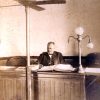calsfoundation@cals.org
United States v. Miller et al.
United States v. Miller et al. originated in the U.S. District Court, Western District of Arkansas, Fort Smith Division when a federal grand jury indicted two men for transporting a sawed-off shotgun from Oklahoma to Arkansas in violation of a federal firearm statute. The case eventually became the single instance in which the U.S. Supreme Court explicitly tackled the Second Amendment in the twentieth century, and it remains controversial to this day.
The National Firearms Act (NFA), Public Law 73-474, effective July 26, 1934, was in reaction to widespread gun violence during the Prohibition era. The NFA required that certain weapons—principally machine guns, sawed-off shotguns and rifles, and silencers—be registered with the federal government and be heavily taxed.
On April 18, 1938, Treasury agents arrested two men in Arkansas for transporting in commerce an unregistered sawed-off shotgun from Claremore, Oklahoma, to Siloam Springs (Benton County) in violation of the NFA. Agents had been watching the two men, Jack Miller and Frank Layton, as they were suspected of being moonshiners and bank robbers.
On January 3, 1939, Fort Smith (Sebastian County) defense attorney Paul Gutensohn, representing both Miller and Layton, filled a demurrer to indictment, insisting that the indictment “offends the inhibition of the Second Amendment to the Constitution,” which states, “A well regulated Militia, being necessary to the security of a free State, the right of the people to keep and bear Arms, shall not be infringed.” Judge Heartsill Ragon of the U.S. District Court for the Western District of Arkansas agreed, granting the motion declaring the NFA unconstitutional. U.S. Attorney Clinton Barry appealed directly to the U.S. Supreme Court.
Gordon Dean argued United States v. Miller et al. before the Supreme Court on March 30, 1939. Defense counsel Gutensohn did not appear, sending a telegram to the Court on March 28, stating that his clients had been unable to pay him for his services.
Justice James Clark McReynolds wrote the unanimous opinion for the Court, delivered on May 15, 1939. The Court reversed the district judge and remanded the case back to the District Court for fact-finding. The Court declared: “In the absence of any evidence tending to show that possession or use of a ‘shotgun having a barrel of less than eighteen inches in length’ at this time has some reasonable relationship to the preservation or efficiency of a well regulated militia, we cannot say that the Second Amendment guarantees the right to keep and bear such an instrument.”
Arguments surround United States v. Miller, principally on three points: one, the absence of the defense to present its side of the case; two, the judge’s statement that the Court was not aware of sawed-off shotguns’ use in the militia; and three, further proceedings never took place. In addition, in Miller, the judge acted on the indictment before the fact-finding trial, and the appeal went directly to the U.S. Supreme Court, not a court of appeals. Further fact-finding for Miller and Layton was not heard by Judge Ragon as directed by the Court for two reasons: Jack Miller was by that time deceased, and Frank Layton pleaded guilty to the charge, after the government won the appeal, and was sentenced by Judge Heartsill Ragon to five years probation on January 8, 1940.
Since Miller, the U.S. Supreme Court did not discuss the Second Amendment in any great detail until 2008. Two 1942 appellate cases cited Miller (Cases v. United States and United States v. Tot), but neither case made it to the Supreme Court, and neither is considered noteworthy. In 2008, the Court ruled against a handgun ban instituted by the District of Columbia, but that ruling did not affect the legal status of the National Firearms Act, which thus remains in effect today.
For additional information:
Act of June 26, 1934, ch. 757, 48 Stat. 1236, National Firearms Act.
Frye, Brian L. “The Peculiar Story of United States v. Miller.” NYU Journal of Law & Liberty 3 (2008): 48–82. Online at http://www.law.nyu.edu/sites/default/files/ECM_PRO_060964.pdf (accessed September 7, 2023).
Halbrook, Stephen P. “The Second Amendment in the Supreme Court: Where It’s Been and Where It’s Going.” Hamlin Law Review 29 (Summer 2006): 449–459. Online at http://www.stephenhalbrook.com/law_review_articles/2nd.amendment.supremecourt.pdf (accessed September 7, 2023).
United States v. Miller, et al., 307 U.S. 174 (1939), No. 696, U.S. Supreme Court. http://caselaw.lp.findlaw.com/scripts/getcase.pl?court=US&vol=307&invol=174 (accessed September 7, 2023).
John Spurgeon
Bella Vista, Arkansas





U.S. v. Miller decided that a sawed-off shotgun was not protected by the 2nd Amendment while taking no action to determine if the NFA could legally regulate them. Interstate commerce requires sale or exchange, and there was none. The NFA created its own definition of commerce that gave the federal government power over interstate transportation not granted by the constitution. The power to tax is specifically to generate revenue, and this law failed to come close. The power was used to punish and should be considered an excess fine and violation of the constitution.
The U.S. Supreme Court in U.S. v. Miller said when mustered into the State Militia, the public is to bring with them their personally owned firearms. This strengthened the 2nd Amendment argument that “we the people” have a right to keep and bear assault rifles.